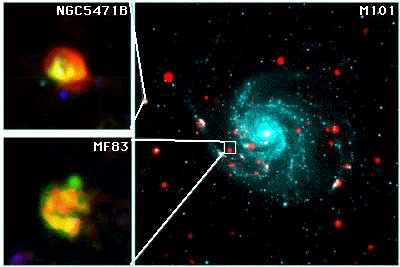Brighter than an Exploding Star, It's a Hypernova!
Brighter than an Exploding Star, It's a Hypernova!
| 20 May 1999 |
In a galaxy not so far away - only 25 million light-years - astronomers have found what looks like are the remnants of strange celestial explosions called hypernovae. "Hypernovae are possibly the most powerful explosions in our Universe since the Big Bang," said Q. Daniel Wang, an astrophysicist at Northwestern University. Such explosions are more powerful than supernovae, the spectacular death gasps of stars some 5-10 times more massive than our Sun. In fact, hypernovae may produce some 100 times more energy than supernovae. But what are these explosions and what causes them? Astronomers are not sure at this point. It is hoped that the discovery of these two suspected hypernova remnants, called MF83 and NGC5471B, located in the nearby spiral galaxy M101 will allow astrophysicists to infer their true nature.
|
The image of M101 seen above result in a combination of an optical image (in blue, from the Palomar Sky Survey Plate) and an X-ray image (in red, from ROSAT). The two suspected hypernova remnants cannot be seen in optical light; they are only visible in X-ray light and in emission lines from some specific atomic activity. The image of NGC5471B is a composite false-color image with HST WFPC-2. The image of MF83 is a false-color image produced with observations made at the Michigan-Dartmouth-MIT Observatory. Image Credit: Y-H. Chu, R. Fresen, D. Matonick, and Q.D. Wang |
Theorists have come up with several plausible explanations for hypernovae. It may be the explosion of a very massive star which has been spinning quickly or is bathed in a powerful magnetic field. Another explanation is that one star in a stellar binary system collides with or merges with its partner. One thing seems clear, however, the result is the formation of a black hole and the release of an enormous amount of energy, primarily in the form of gamma-rays. Gamma-rays are the most energetic form of light. They possess some 10,000 to 10 million times more energy than the light we see with our eyes.
Hypernovae may explain the mysterious phenomena known as gamma-ray bursts. Since their discovery in the 1960s, gamma-ray bursts (GRBs) have been determined to occur randomly in the sky, at random times. Once they fade, we never see a burst from that location again. Bohdan Paczynski of Princeton University proposed in 1998 that hypernovae were a way to explain GRBs. However, little is currently known about the true nature of either hypernovae or GRBs. "I suspect GRBs may well be the tip of an iceberg, as we have no clue why some explosions generate so much gamma-ray emission," Paczynski said.
Wang's observations were made primarily with data from the joint German/UK/US mission ROSAT. Follow-up optical observations by You-Hua Chu of the University of Illinois and her collaborators for NGC5471B and by David Matonick and Rob Fresen of Dartmouth College for MF83 were made with the Hubble Space Telescope and at the Kitt Peak Observatory. Combining all of the observations allowed Wang to calculate the energy required to produce the to remnants based on their size, expansion velocity, and X-ray brightness. "They must have come from spectacular explosions. They are bright even at a distance of 25 million light-years away." By bright, Wang means bright in the amount of X-ray radiation they produce. The two remnants cannot be seen in a typical optical image.


